Intel’s Silvermont Architecture Revealed: Getting Serious About Mobile
by Anand Lal Shimpi on May 6, 2013 1:00 PM EST- Posted in
- CPUs
- Intel
- Silvermont
- SoCs
ISA
The original Atom processor enabled support for Merom/Conroe-class x86 instructions, it lacked SSE4 support due to die/power constraints; that was at 45nm, at 22nm there’s room for improvement. Silvermont brings ISA compatibility up to Westmere levels (Intel’s 2010 Core microprocessor architecture). There’s now support for SSE4.1, SSE4.2, POPCNT and AES-NI.
Silvermont is 64-bit capable, although it is up to Intel to enable 64-bit support on various SKUs similar to what we’ve seen with Atom thus far.
IPC and Frequency
The combination of everything Intel is doing on the IPC front give it, according to Intel, roughly the same single threaded performance as ARM’s Cortex A15. We’ve already established that the Cortex A15 is quite good, but here’s where Silvermont has a chance to pull ahead. We already established that Intel’s 22nm process can give it anywhere from a 18 - 37% performance uplift at the same power consumption. IPC scaling gives Silvermont stable footing, but the ability to run at considerably higher frequencies without drawing more power is what puts it over the top.
Intel isn’t talking about frequencies at this point, but I’ve heard numbers around 2 - 2.4GHz thrown around a lot. Compared to the 1.6 - 2GHz range we currently have with Bonnell based silicon, you can see how the performance story gets serious quickly. Intel is talking about a 50% improvement in IPC at the core, combine that with a 30% improvement in frequency without any power impact and you’re now at 83% better performance potentially with no power penalty. There are other advantages at the SoC level that once factored in drive things even further.
Real Turbo Modes & Power Management
Previous Atom based mobile SoCs had a very crude version of Intel’s Turbo Boost. The CPU would expose all of its available P-states to the OS and as it became thermally limited, Intel would clamp the max P-state it would expose to the OS. Everything was OS-driven and previous designs weren’t able to capitalize on unused thermal budget elsewhere in the SoC to drive up frequency in active parts of chip. This lack of flexibility even impacted the SoC at the CPU core level. When running a single threaded app, Medfield/Clover Trail/et al couldn’t take thermal budget freed up by the idle core and use it to drive the frequency of the active core. Previous Atom implementations were basically somewhere in the pre-Nehalem era of thermal/boost management. From what I’ve seen, this is also how a lot of the present day ARM architectures work as well. At best, they vary what operating states they expose to the OS and clamp max frequency depending on thermals. To the best of my knowledge, none of the SoC vendors today actively implement modern big-core-Intel-like frequency management. Silvermont fixes this.
Silvermont, like Nehalem and the architectures that followed, gets its own power control unit that monitors thermals and handles dynamic allocation of power budget to various blocks within the SoC. If I understand this correctly, Silvermont should expose a maximum base frequency to the OS but depending on instruction mix and available TDP it can turbo up beyond that maximum frequency as long as it doesn’t exceed TDP. Like Sandy Bridge, Silvermont will even be able to exceed TDP for a short period of time if the package temperature is low enough to allow it. Finally, Silvermont’s turbo can also work across IP blocks: power budget allocated to the GPU can be transferred to the CPU cores (and vice versa).
By big-core standards (especially compared to Haswell), Silvermont’s turbo isn’t all that impressive but compared to how things are currently handled in the mobile space this should be a huge step forward.
On the power management side, getting in and out of C6 should be a bit quicker. There's also a new C6 mode with cache state retention.


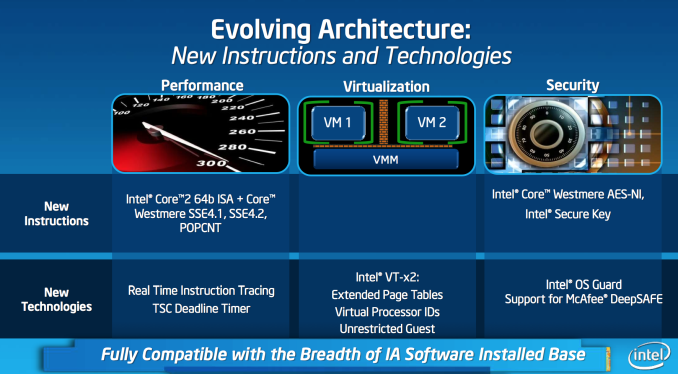
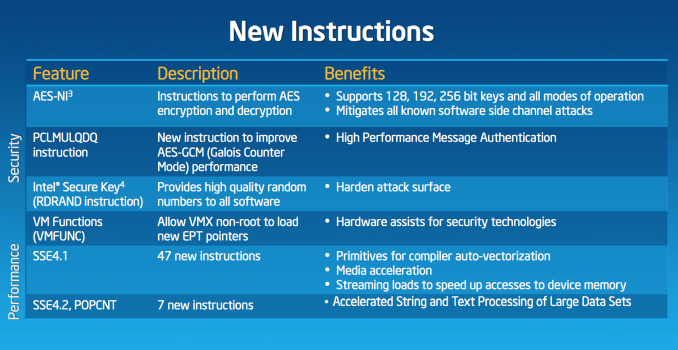
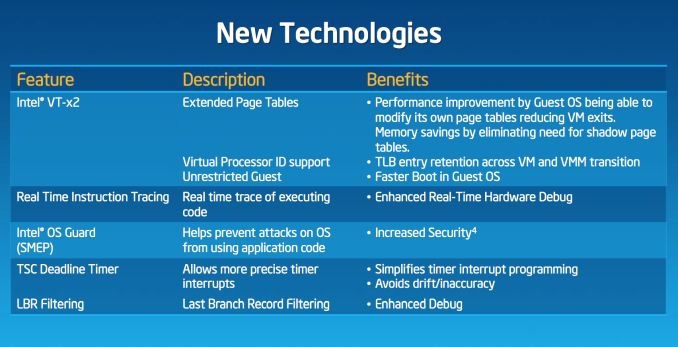
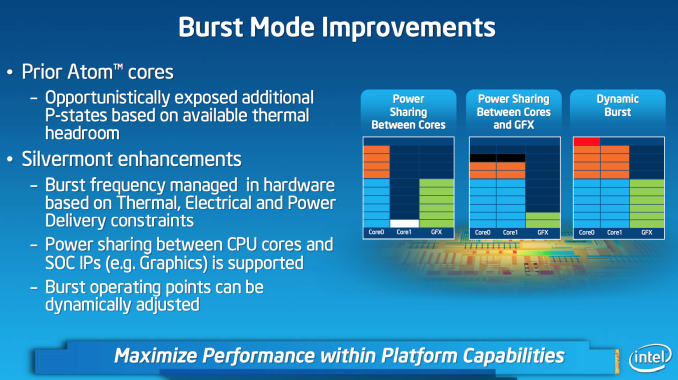
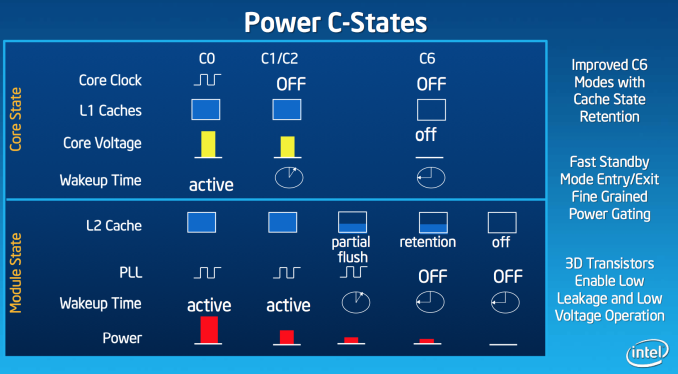








174 Comments
View All Comments
extide - Wednesday, May 8, 2013 - link
What does Tegra 4 do 1.9Ghz in?Wilco1 - Wednesday, May 8, 2013 - link
Rumour is that it goes in the next ZTE phone out in a few months.phoenix_rizzen - Tuesday, May 7, 2013 - link
Note: Tegra 4i does *not* use Cortex-A15 CPUs, it uses Cortex-A9 CPUs! In fact, there's very little "Tegra 4" in the "Tegra 4i" other than the name.lmcd - Monday, May 13, 2013 - link
And the GPU is closer to the 4 than 3.And the process node. Oh yeah, that.
name99 - Monday, May 6, 2013 - link
You're willfully missing the point (and I say that as someone who's not convinced it will be easy for Intel to get ahead).What is the value of high speed CPUs in a phone (or for that matter a tablet, or a desktop machine)? For most users it is NOT that it allows some long computation to take a shorter time; rather it's that it provides snappiness --- it allows something that would have taken 1/40th of a sec to take 1/60th of a sec, or that would have taken 1/3rd of a sec to take 1/4 of a sec.
In this world, where snappiness is what matters, the ability to run your CPU at very high speeds for very short bursts of time (as long as this does not cost you long-run power) is an exceedingly valuable asset. You're being very stupid to dismiss it.
dig23 - Thursday, May 9, 2013 - link
I think so too. This article sounds totally biased :(bkiserx7 - Monday, May 6, 2013 - link
I wish they would go all out and lay it all on the table. I think it would drive great competition through the industry.Gigaplex - Tuesday, May 7, 2013 - link
Agreed. And if it does come out "too good", just downclock it and get even better battery life.jamesb2147 - Monday, May 6, 2013 - link
This is, by far, the worst article I've ever read on Anandtech. I'm pulling you out of my RSS feed specifically because of this article.Post when you have specs, guys, not Intel slides. I don't want to see the word "should."
Homeles - Monday, May 6, 2013 - link
AnandTech's architectural analyses are some of the best in the industry. It's your loss.